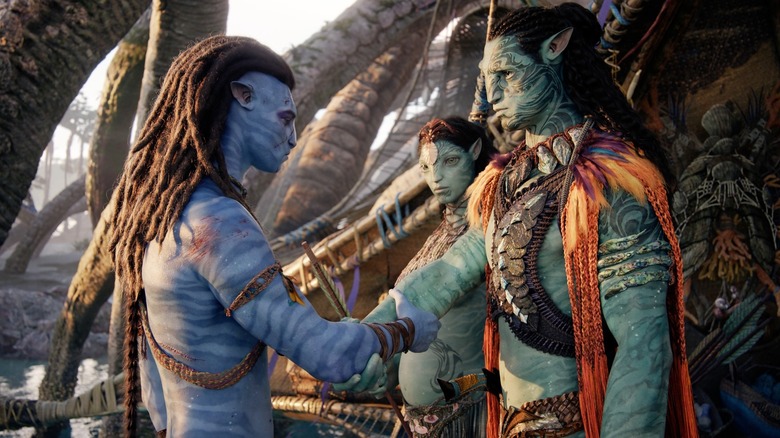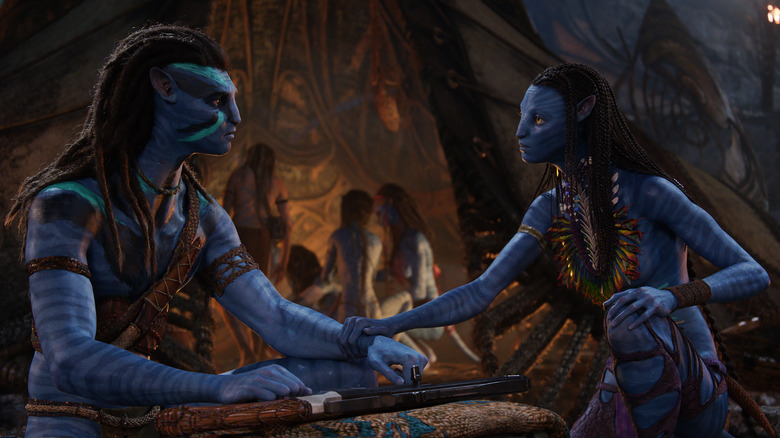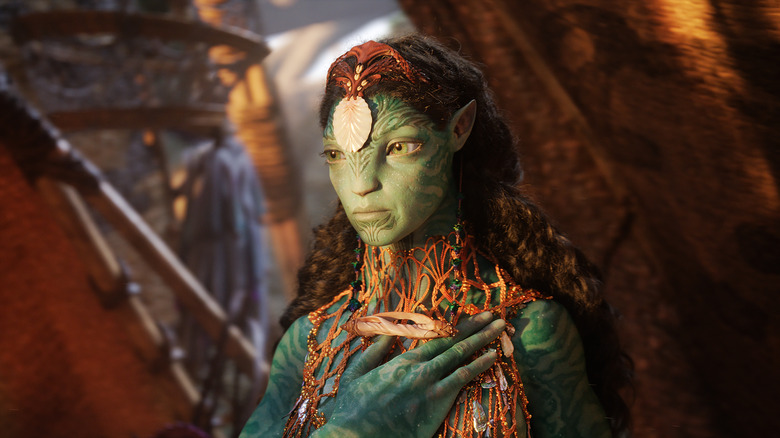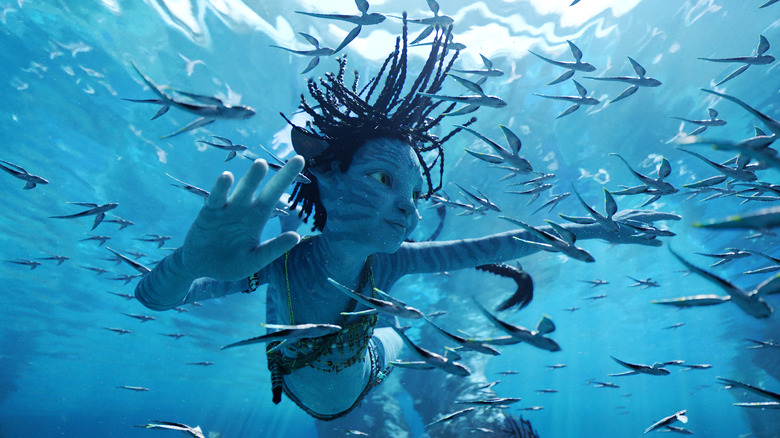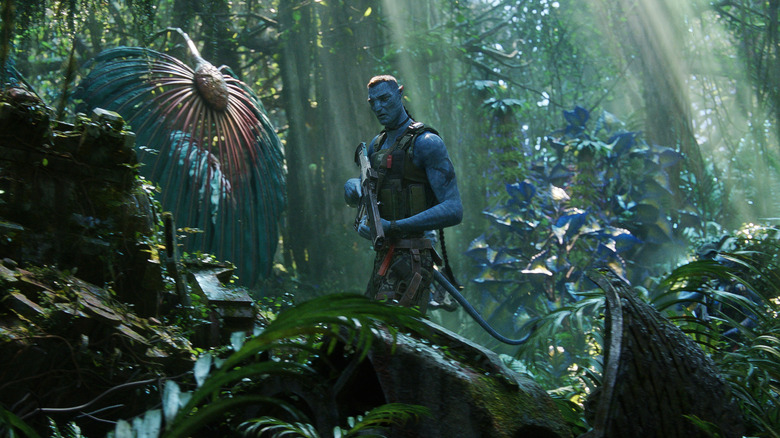Avatar: The Way Of Water Required Intricate, Tangible Costumes Before Entering The Digital World
Obviously, much of the critical acclaim for "Avatar: The Way of Water" is directed at its visual effects. The clarity, imagination, and beauty on display truly astounded me, whether I was seeing it in standard 2D or in IMAX 3D HFR. But while so much of the VFX discussion revolves around the advancements in performance capture, there are many other visual effects in the movie that we don't even think about.
For the vast majority of the film, we are looking at things entirely created in computers. That includes the costumes, which is something I completely took for granted upon seeing it. We understand that these are digital characters, but I think our minds process it to where the computers just alter their heights, skin color, and face shape. Surely, what they are wearing must be real. But of course, it isn't.
Visual effects artists are many things, but what they aren't by trade are costume designers. Designing clothing that is specific, practical, culturally correct, and aesthetically pleasing is something people spend their entire lives dedicated to and produce truly amazing results. For a film like "Avatar: The Way of Water," that means inventing entirely new clothing for an alien species that is made up from whole cloth. So, for that to be done correctly, director James Cameron needed true blue costume designers to create the looks of the Na'vi.
However, these are not artists used to working in an entirely digital space; clothing requires tangibility. Cameron, having the resources available to him, knew that in order for the digital clothing to feel real, it first needed to exist in the real world.
'People misconstrue that everything is done on a computer'
The best visual effects always derive from something real as a reference point. This is why the performance capture in the "Avatar" films is a necessity to make those characters work; they can't exist without the actual performances of those actors. The same goes with the costumes. In the book "The Art of Avatar: The Way of Water," producer Jon Landau said of conceptualizing the costumes, "If we wanted Weta FX to create digital costumes that looked photoreal and moved authentically, we needed to give them something tactile to benchmark against."
This was a mindset derived from the first "Avatar" movie and became even more prevalent on the sequel with costume designer Deborah L. Scott, who has worked with James Cameron going back to "Titanic." She credits Cameron for investing in the practical costuming side of the production:
"It's a symptom of these kinds of movies that people misconstrue that everything is done on a computer ... Through the process of the first movie, Jim became a huge advocate of the fact that you need to make costumes, because there're a lot of things that digital artists can't do."
This should be the way it is always done. You need to understand how fabrics work together, how they stretch and interact with the body. And you simply aren't going to be able to understand that unless you are using a needle and thread. Doing it this way also gives the visual effects artists an amazing reference for when costuming moves over to the digital production side of things. In a world that is entirely artificial, that reality is exactly what those artists need.
Defining cultures
By using a vast array of fabrics and materials, you also are able to give each character their own distinct look, which in a film like "Avatar: The Way of Water" is exceptionally important. Not only does it help to distinguish characters who very easily could end up looking like indistinguishable large blue things, but the contrasts (and conflicts) between two distinct Na'vi clans are key to the story. On Earth, no two cultures dress exactly the same; climates, environments, and traditions dictate so much about how people dress, and Deborah L. Scott wanted to bring that over to the "Avatar" series. As she puts it:
"Along with building the characters, you're also building cultures. You're giving the audience another deeper, broader look into what it is like to be Omatikayan. In ['Avatar: The Way of Water'], you also have to do the same for a second clan, the Metkayina, an aquatic-based tribe, and a whole influx of new human characters."
Having the ability to source different kinds of materials in the real world makes it possible to construct a costume piece that can not only be worn in a practical way, but also tailored specifically for an individual, which is not exactly something you can do in a digital space. Purely digital costume design runs the risk of things looking incredibly similar, because you are working with the same tools for every costume, but that can't happen if you want cultural specificity in your costuming. Producer Jon Landau explains: "Costume-wise, you shouldn't have to look, no matter whose body it's on, and wonder which clan it is."
Yes, the skin-shading and anatomical differences help with this too, but the costuming plays a significant role in establishing identity on Pandora.
Oh, yeah, and they have to be underwater
Making things even more difficult for both the costume and visual effects departments is how much of the film takes place underwater. Nearly all of people's experience designing costumes is not for underwater use. Yes, there are bathing suits and wetsuits, but those are not things we wear all the time. However, in this world, they do. In "The Art of Avatar: The Way of Water," James Cameron explained how it was imperative that these costumes be designed practically first:
"We have underwater costumes now ... We had to learn how they move, the way in which fabrics are constructed, whether it was fringe elements or fabric elements or beaded elements, and then how they behaved underwater. Then I had to go back into the design. We couldn't just design something and build it. You had to find out what worked, then incorporate that back into the design."
Imposing the onus of how textiles interact with water first on the people who have never made clothes before simply wouldn't have achieved the same results. It's not like these Na'vi characters are just going to be in Billabong board shorts or whatever. A whole new fashion needed to be created for underwater use, and the best place to test the practicalities of it and the way the fabrics behaved in water was the real world.
'If we can't make it, we shouldn't draw it'
Every single element of "Avatar: The Way of Water" feels completely lived in and real. Nothing about it seems to exist purely for the sake of aesthetic beauty; it all needed to have a function that makes sense. This is why creating it all for real was a requirement. As Deborah L. Scott explains:
"It became very, very apparent, and it still is, that design and manufacture work hand-in-hand. Because if we can't make it, we shouldn't draw it. And that doesn't mean you limit yourself. But it was a very interesting process to watch the making become equal to or more important than the actual designs."
The results speak for themselves. I cannot remember a time where an entirely digital environment in a movie felt utterly real to me. Probably not since the first "Avatar." The costuming does so much to sell that precisely because it isn't something we think of as needing to be created in a computer. And the reason we don't is because before it made its way to the desktops of digital effects artists, it was real. They made sure of it.
